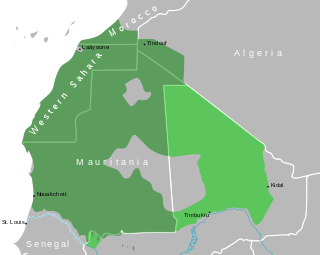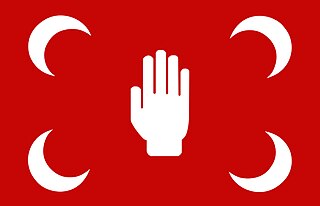
Demographic features of the population of Morocco include population density, ethnicity, education level, health of the populace, economic status, religious affiliations and other aspects of the population. The population of Morocco in 2021 is 37.271 million.
The history of Western Sahara can be traced back to the times of Carthaginian explorer Hanno the Navigator in the 5th century BC. Though few historical records are left from that period, Western Sahara's modern history has its roots linked to some nomadic groups such as the Sanhaja group, and the introduction of Islam and the Arabic language at the end of the 8th century AD.

Berbers, or the Berber peoples, also known as Amazigh or Imazighen, are a diverse grouping of distinct ethnic groups indigenous to North Africa who predate the arrival of Arabs in the Maghreb. Their main connections are identified by their usage of Berber languages, most of them mutually unintelligible, which are part of the Afroasiatic language family.

Moulay Ismail Ibn Sharif was a Sultan of Morocco from 1672 to 1727, as the second ruler of the 'Alawi dynasty. He was the seventh son of Moulay Sharif and was governor of the province of Fez and the north of Morocco from 1667 until the death of his half-brother, Sultan Moulay Rashid in 1672. He was proclaimed sultan at Fez, but spent several years in conflict with his nephew Moulay Ahmed ben Mehrez, who also claimed the throne, until the latter's death in 1687. Moulay Ismail's 55-year reign is the longest of any sultan of Morocco. During his lifetime, Isma’il amassed a harem of over 500 women with more than 800 confirmed biological children, making him one of the most prodigious fathers in recorded history.

Beni Ḥassan is a Bedouin Arab tribe which inhabits Western Sahara, Mauritania, Morocco and Algeria. It is one of the four sub-tribes of the Banu Maqil who emigrated in the 11th century from South Arabia to the Maghreb with the Banu Hilal and Banu Sulaym Arab tribes. In the 13th century, they took the Sanhaja territories in the southwest of the Sahara. In Morocco, they first settled, alongside their Maqil relatives, in the area between Tadla and the Moulouya River. The Sous Almohad governor called upon them for help against a rebellion in the Sous, and they resettled in and around that region. They later moved to what is today Mauritania, and from the 16th century onwards, they managed to push back all black peoples southwards to the Senegal Valley river. The Beni Hassan and other warrior Arab tribes dominated the Sanhaja Berber tribes of the area after the Char Bouba war of the 17th century. As a result, Arabs became the dominant ethnic group in Western Sahara and Mauretania. The Bani Hassan dialect of Arabic became used in the region and is still spoken, in the form of Hassaniya Arabic. The hierarchy established by the Beni Hassan tribe gave Mauritania much of its sociological character. That ideology has led to oppression, discrimination and even enslavement of other groups in Mauritania.

The Sahrawis, or Sahrawi people, are an ethnic group native to the western part of the Sahara desert, which includes the Western Sahara, southern Morocco, much of Mauritania, and along the southwestern border of Algeria. They are of mixed Hassani Arab and Sanhaji Berber descent, as well as West African and other indigenous populations.

The Zenata are a group of Berber tribes, historically one of the largest Berber confederations along with the Sanhaja and Masmuda. Their lifestyle was either nomadic or semi-nomadic.

The Sanhaja were once one of the largest Berber tribal confederations, along with the Zanata and Masmuda confederations. Many tribes in Algeria, Libya, Mali, Mauritania, Morocco, Niger, Senegal, Tunisia and Western Sahara bore and still carry this ethnonym, especially in its Berber form.

Guelmim is a city in southern Morocco, often called Gateway to the Desert. It is the capital of the Guelmim-Assif Noun region which includes southern Morocco and the northeastern corner of Western Sahara. The population of the city was 187,808 as of the 2014 Moroccan census, making it the largest city in the region. The N1 and N12 highways cross at Guelmim and link it to the nearby region of Souss-Massa.
The Lamtuna are a nomadic Berber tribe belonging to the Iẓnagen / Sanhaja (Zenaga) confederation, who traditionally inhabited areas from Sous to Adrar Plateau. During the Almoravid period, many Lamtunas emigrated northwards. Currently, the Lemtuna Tribe is based in the South of Mauritania. The chief of this Tribe is Mr. Limam Ould Teguedi. Among notable families are the family of Ehl Aly Ibn Ibrahim, the family of Ehel Sidelemine, Ehl Abdawa, Ehl Mohamed El-Emine and Ehl Mohammed Ghali. Sahrawi Tajakant as well as Messouma tribes are of the most recognisable offshoots of the Lamtunas. They inhabit areas in Algeria, Morocco, Mauritania and Western Sahara. The Banu Ghaniya, the successors of this dynasty in Tripoli and the Nafusa Mountains and the governors of the Spanish Balearic Islands until about the middle of the 13th century, originated from this tribe as well.

The Army of Liberation was an organization of various loosely united militias fighting for the independence of Morocco from the French-Spanish protectorate.

The Reguibat is a Sahrawi tribal confederation of mixed Arab and Sanhaja Berber origins. The Reguibat speak Hassaniya Arabic, and are Arab in culture. They claim descent from Sidi Ahmed al-Reguibi, an Arab Islamic preacher from Beni Hassan who settled in Saguia el-Hamra in 1503. They also believe that they are, through him, a chorfa tribe, i.e. descendants of Muhammad. Religiously, they belong to the Maliki school of Sunni Islam.
The Tajakant is a Sahrawi tribe of Berber Sanhaja origins. They speak Hassaniya Arabic.

Igawawen or Gawawa, mostly known as Zwawa were a group of Kabyle tribes inhabiting the Djurdjura mountains, Greater Kabylia, in Algeria. The Zouaoua are a branch of the Kutama tribe of the Baranis Berbers.
Maghrebi Arabs or North African Arabs are the inhabitants of the Maghreb region of North Africa whose ethnic identity is Arab, whose native language is Arabic and trace their ancestry to the tribes of the Arabian Peninsula. This ethnic identity is a product of the centuries-long Arab migration to the Maghreb since the 7th century, which changed the demographic scope of the Maghreb and was a major factor in the ethnic, linguistic and cultural Arabization of the Maghreb region. The descendants of the original Arab settlers who continue to speak Arabic as a first language currently form the single largest population group in North Africa.

The Zawiya Dila'iya, also known as the Zawiyaof Dila and the Dila'iya Sultanate, was a Sufi brotherhood, centred in the Middle Atlas range of Morocco.
The Aït Oussa, is a large Adnani and Qahtani Arab tribe in Western Sahara and Morocco, the members of Ait Oussa are Sahrawis, descended from Banu Hilal and Banu Aws. Muhammed Sulayman Al-Tayeb classifies Ait Oussa as an Arab tribe.
The Azwafit or Azwafayt is a Sahrawi tribe of Bedouin Arab origin.

The Sous expedition were a series of military expeditions conducted by Sultan Moulay Hassan of Morocco in the Sous region between 1882 and 1895. As a result of these campaigns, a series of Moroccan posts were established to the south of Agadir: at Tiznit, Kasbah Ba Amrane, Assaka and at Guelmim. In addition to these posts, the more obvious and more commanding points of governmental control, Moulay Hassan also invested with official authority many of the local qaids in southwestern Morocco—such as the Qaid of Oued Noun, Dahman ben Bayruk, and the Qaid of Tazerwalt. An investiture of Moroccan authority was as well accorded to the qaids of the Ait Oussa and the Tajakant.

The Battle of Smara occurred between October 5 and 8, 1979, during the Western Sahara War at Smara, between the Royal Moroccan Armed Forces and the Polisario Front. Both sides asserted divergent narratives of the battle.














